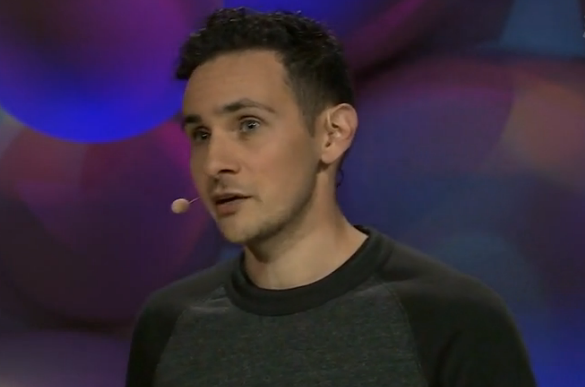(单词翻译:单击)
听力文本
So, even the more objective parts about being human are hard to describe. Like, conversation.
甚至很多关于人性的客观方面也很难描述。比如,对话。
Have you ever really tried to break down the steps?
你曾经尝试过分解谈话的步骤吗?
So think about sitting with your friend at a coffee shop and just having small talk.
试着想象一下,你和你的朋友坐在咖啡馆,进行简单的交谈。
How do you know when to take a turn? How do you know when to shift topics?
你怎么知道轮到你说话了?你怎么知道什么时候该转换话题?
And how do you even know what topics to discuss?
你怎么知道要讨论些什么?
See, most of us don't really think about it, because it's almost second nature.
大多数人都不会想这些问题,因为这对我们来说是很自然的。
And when we get to know someone, we learn more about what makes them tick, and then we learn what topics we can discuss.
当我们认识一个人的时候,我们会对他们越来越了解,然后我们会知道能聊些什么话题。
But when it comes to teaching AI systems how to interact with people, we have to teach them step by step what to do.
但是,当你教人工智能怎样与人类互动时,我们需要一步一步教它们该如何做。
And right now, it feels clunky.
而现在,这个过程还感觉很笨拙。
If you've ever tried to talk with Alexa, Siri or Google Assistant, you can tell that it or they can still sound cold.
如果你曾尝试和Alexa、Siri或谷歌助手聊天,你可以感觉得到,它们仍听上去冷冰冰的。
And have you ever gotten annoyed when they didn't understand what you were saying
你是否曾经因为它们不明白你说什么而变得恼怒,
and you had to rephrase what you wanted 20 times just to play a song?
比如为了让它们放一首歌,你得说上20次?

Alright, to the credit of the designers, realistic communication is really hard.
不过我们也要理解设计师,毕竟让机器学会真实的沟通是非常难的。
And there's a whole branch of sociology, called conversation analysis,
有一个社会学的分支,叫做会话分析,
that tries to make blueprints for different types of conversation.
它尝试做不同对话类型的蓝图。
Types like customer service or counseling, teaching and others.
例如像客户服务、心理咨询、教授课程等等的会话类型。
I've been collaborating with a conversation analyst at the lab to try to help our AI systems hold more human-sounding conversations.
我已经在和会话分析学家在实验室展开合作,尝试帮助我们的人工智能系统进行更多的人性化的对话。
This way, when you have an interaction with a chatbot on your phone or a voice-based system in the car,
这样,当你和手机聊天机器人进行互动时,或者和车载语音系统互动时,
it sounds a little more human and less cold and disjointed.
这种声音就听上去更人性,不那么冷淡和缺乏逻辑。
So I created a piece of art that tries to highlight the robotic, clunky interaction to help us understand, as designers,
我创造的这个艺术品,重点突显了机械化的、笨拙的互动方式,以帮助我们这些设计师明白,
why it doesn't sound human yet and, well, what we can do about it.
为什么它听上去不像人类,我们该如何解决这个问题。
The piece is called Bot to Bot and it puts one conversational system against another and then exposes it to the general public.
这个艺术品叫Bot to Bot,它将一个会话系统搭建在另一个会话系统之上,然后展示给公众。
And what ends up happening is that you get something that tries to mimic human conversation, but falls short.
最终会发生的就是,它尝试模仿人类的对话,但是却明显有不足之处。
Sometimes it works and sometimes it gets into these, well, loops of misunderstanding.
有的时候它还可以,而有的时候会陷入误解的循环。
So even though the machine-to-machine conversation can make sense, grammatically and colloquially,
虽然机器与机器的对话从语法、用意上能让人明白,
it can still end up feeling cold and robotic.
但是你还是能感觉到这个对话的冰冷和机械化。
And despite checking all the boxes, the dialogue lacks soul and those one-off quirks that make each of us who we are.
尽管对话的其他要素都具备,但却缺少了灵魂,缺少了那些使我们之所以为人类的特质。
演讲介绍
怎样才能让人类真正地与人工智能进行互动?拉斐尔·阿拉尔建议我们从创造艺术开始。他分享了能让人工智能探究复杂想法的交互项目,例如怀旧、直觉、对话——所有的工作都在朝着将来人工智能尽可能和人类一样的目标而努力。


